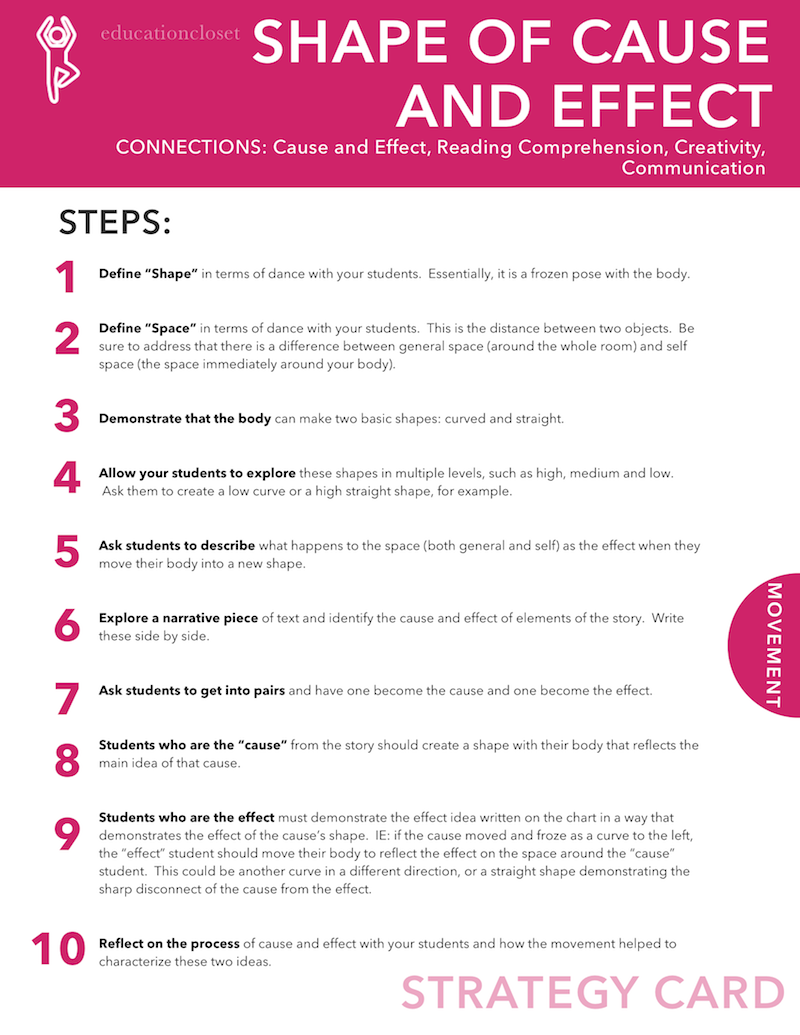Susan Riley | September 2013
The Shape of Cause and Effect
As is so often requested by our readers, today’s post is going to be a strategy post which connects Dance with Cause and Effect. Movement can be such an easy access point for many of our active learners, but is often times difficult for teachers to implement because of their own discomfort with using their bodies. This cause and effect activity will hopefully provide a comfortable medium for both teachers and learners to use to make positive connections. As always, please remember that this is a strategy and not a full lesson!
Background
In dance, much of movement is centered around shapes and space. Additionally, for every use of the space around them, there is an effect on the space that remains. For instance, if you lean your torso to the right, there is suddenly more space to your left and less space to your right. In literacy, cause and effect should be explored explicitly as a way to develop richer comprehension of the text.
Grade Level
This cause and effect activity can be used in a variety of grade levels depending on the text selection.
Directions
1. Define “Shape” in terms of dance with your students. Essentially, it is a frozen pose with the body.
2. Define “Space” in terms of dance with your students. This is the distance between two objects. Be sure to address that there is a difference between general space (around the whole room) and self space (the space immediately around your body).
3. Demonstrate that the body can make two basic shapes: curved and straight.
4. Allow your students to explore these shapes in multiple levels, such as high, medium and low. Ask them to create a low curve or a high straight shape, for example.
5. Ask students to describe what happens to the space (both general and self) as the effect when they move their body into a new shape.
6. Explore a narrative piece of text and identify the cause and effect of elements of the story. Write these side by side.
7. Ask students to get into pairs and have one become the cause and one become the effect.
8. Students who are the “cause” from the story should create a shape with their body that reflects the main idea of that cause.
9. Students who are the effect must demonstrate the effect idea written on the chart in a way that demonstrates the effect of the cause’s shape. IE: if the cause moved and froze as a curve to the left, the “effect” student should move their body to reflect the effect on the space around the “cause” student. This could be another curve in a different direction, or a straight shape demonstrating the sharp disconnect of the cause from the effect.
10. Reflect on the process of cause and effect with your students and how the movement helped to characterize these two ideas.
DOWNLOAD THIS CARD
Story selections that could be used for the text:
Primary: If You Give a Mouse a Cookie, The Very Hungry Caterpillar, The Dot
Intermediate: Where the Wild Things Are, The Great Kapok Tree, The Giving Tree
Middle: A Wrinkle in Time, The Adventures of Tom Sawyer
High: The Odyssey, The Gift of the Magi, To Kill a Mockingbird




